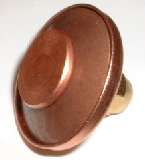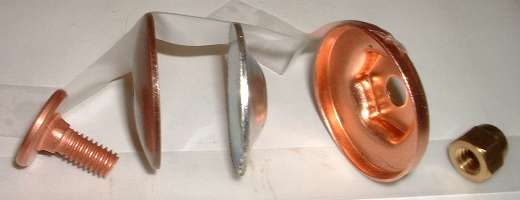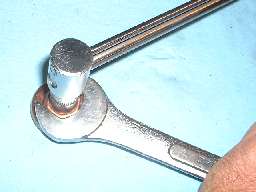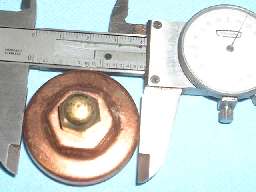The MGA With An Attitude
CORE PLUG for Emergency - CO-105A
I hear occasionally (too often actually) about a core plug popping out of an engine block and spilling out all of the coolant. This most often happens soon after an engine overhaul where the core plugs were replaced, and often with the first drive which gets the engine up to full operating temperature (first pressurized coolant). This indicates that the core plug was not installed properly (so best check the rest of them as well).
If the new core plugs stay in place through a few heat and cool down cycles, they will most likely stay put for many years of harsh running. But it is not unheard of that a core plug might pop out unexpectedly at any time. Another common case is with old core plugs which have been in place for years, maybe even decades, and may be rusted thin enough to deform from normal cooling system pressure. Whatever the reason for failure, if it happens only once in your life time it has to potential to really spoil your day (to put it mildly).
A simple standard domed core plug is cheap (maybe a dollar) and small enough to pack in your tool kit like a large steel washer. But installation of the domed core plug requires space enough to swing a hammer. That may be okay for some locations, but in some cases you may have barely enough space for fingers and a wrench. The core plug in the back of the engine block next to the firewall is a good example. In this case a wrench in place core plug may save the day.

 This little jewel is a bit more expensive, perhaps $5 at any auto parts store, but well worth it when needed. It is an all metal expansion plug with no rubber or plastic parts, so it can make a permanent installation. In fact it is advertised to have blowout pressure resistance to 300 PSI. 1-5/8" diameter is the size for the B-series engine. The 1-5/8" diameter plug has Dorman part number 568-010, available at most any local auto parts store. This may sometimes be called a "Quick-Seal" plug, as that is the Dorman registered trade name. See Dornam web site.
This little jewel is a bit more expensive, perhaps $5 at any auto parts store, but well worth it when needed. It is an all metal expansion plug with no rubber or plastic parts, so it can make a permanent installation. In fact it is advertised to have blowout pressure resistance to 300 PSI. 1-5/8" diameter is the size for the B-series engine. The 1-5/8" diameter plug has Dorman part number 568-010, available at most any local auto parts store. This may sometimes be called a "Quick-Seal" plug, as that is the Dorman registered trade name. See Dornam web site.

Inside it has a wide head square shank steel bolt, heavily copper plated for corrosion resistance, with 5/16-18 UNC thread. This is followed by a heavily copper plated domed steel washer .060" thick and .220" total height. Next is a slightly heavier steel washer, .068" thick, with a mildly conical base and higher domed center and .305" overall height. These domed washers have the flat sides facing each other like a pair of band symbols. On the outside is a thinner copper shell .035" thick, with a nearly cylindrical edge which wraps fully around the other two washers. This shell also has a raised crown in the form of a 7/8" hex head to serve as a wrench grip. Finally on the outside is a brass 5/16-18 acorn nut.
When assembled the outer shell has a small space of about .055" from the top of the outer steel washer. This allows the thin copper shell to crush slightly inward in the center, but the real purpose of the space is to assure that the two washers will be pulled tightly into the shell before any expansion occurs.
When first assembled loosely the acorn nut screws onto the stud about one turn after secure engagement of the thread, then comes to rest against the copper shell. At this point you need to insert the assembly into the counterbore of the core port on the engine block. Tap it gently into place to be sure that the outer flange of the shell is fully seated into the counterbore. Then hold the hex on the shell with one wrench while turning the acorn nut with another wrench.
The first one turn of the nut will force the center of the copper shell inward to come to bear against the steel washer. More tightening of the nut will pull the center of the thinner (copper plated) domed washer outward to flatten out the dome and expand the outer diameter. The pain steel washer will maintain its original shape, as it is thicker and stiffer and will not bend. The acorn nut should be tightened about two turns to affect minimally secure installation, after which you may remove the larger wrench, and the assembly should not turn with further tightening of the nut.

 The nut may be screwed on one turn with initial engagement, one additional turn to bring the copper shell into contact with the steel washer, and up to three additional turns to compress the copper plated domed washer nearly flat for maximum expansion force. At that point the acorn nut will bottom out on the end of the stud, which should be obvious when it wants to suddenly stop turning with much greater resistance. So even though it may only require about two turns to minimally secure this plug, continuing to tighten it to the limit of travel of the nut should not cause any damage to the engine block. This is simply the equivalent of tapping a standard domed core plug to nearly flat condition.
The nut may be screwed on one turn with initial engagement, one additional turn to bring the copper shell into contact with the steel washer, and up to three additional turns to compress the copper plated domed washer nearly flat for maximum expansion force. At that point the acorn nut will bottom out on the end of the stud, which should be obvious when it wants to suddenly stop turning with much greater resistance. So even though it may only require about two turns to minimally secure this plug, continuing to tighten it to the limit of travel of the nut should not cause any damage to the engine block. This is simply the equivalent of tapping a standard domed core plug to nearly flat condition.


I measured the torque here, and it required about 12 lb-ft torque to pull the dome washer nearly flat. OD of the plug was increased from 1.615" to 1.635, which is more than enough to make a the ultimately tight fit in the 1.625" counterbore of the engine block. The hex on the thin outer shell of the plug is slightly tapered, and the material is soft. This makes it important to hold the 7//8" wrench securely in place for initial tightening to prevent it from slipping off or rounding off the corners of the hex.
When this plug is finally installed the flattened dome washer will bear radially very strongly against the inside of the cylindrical flange of the copper shell. The shell in turn will be pressed radially very strongly against the bore in the core port of the engine block. This strong radial force will affect a good seal against both outside and inside of the flange on the thin copper shell. The wide head of the stud being pulled hard to deform the domed washer will affect a good seal between those two heavily copper plated surfaces. As such the plain steel washer should remain in a dry space. If perchance the inner most seal (domed washer to shell) should breach and allow liquid into the space around the plain steel washer, the acorn nut should still secure a good seal against the thin copper shell on the outside face.
As with the standard domed steel core plug, if you are apprehensive about the smoothness of the counterbore in the block you might add a touch of silicone sealant to the port before installation of the plug.
|

 This little jewel is a bit more expensive, perhaps $5 at any auto parts store, but well worth it when needed. It is an all metal expansion plug with no rubber or plastic parts, so it can make a permanent installation. In fact it is advertised to have blowout pressure resistance to 300 PSI. 1-5/8" diameter is the size for the B-series engine. The 1-5/8" diameter plug has Dorman part number
This little jewel is a bit more expensive, perhaps $5 at any auto parts store, but well worth it when needed. It is an all metal expansion plug with no rubber or plastic parts, so it can make a permanent installation. In fact it is advertised to have blowout pressure resistance to 300 PSI. 1-5/8" diameter is the size for the B-series engine. The 1-5/8" diameter plug has Dorman part number 


